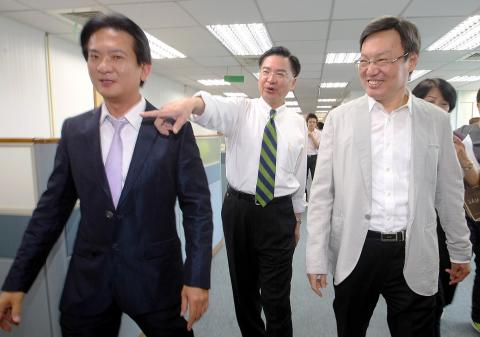|
KMT beyond ‘1992 consensus’: DPP
MOOT POINT? The DPP held a forum on how to deal
with the ‘1992 consensus,’ but participants said the KMT has already moved on to
accepting a ‘one China’ framework
By Chris Wang / Staff reporter

Joseph Wu, executive director of
the Democratic Progressive Party’s (DPP) Policy Research Committee, center,
accompanies former National Security Council secretary-general Su Chi of the
Chinese Nationalist Party (KMT), right, at the DPP’s headquarters in Taipei
yesterday.
Photo: CNA
The so-called “1992 consensus” has been
abandoned by both the Chinese Nationalist Party (KMT) and Beijing, as both are
now adhering to the “one China” framework (一中框架), members of the Democratic
Progressive Party (DPP) told a forum yesterday.
The closed-door meeting on how the party should deal with the “1992 consensus,”
which was widely considered the primary reason behind its loss in the
presidential election last year, was the second of nine scheduled forums on
major China policy issues the DPP has arranged.
The DPP has never recognized the existence of such a consensus. While both the
KMT and the Chinese Communist Party (CCP) recognized the initiative, they
defined it differently, with the KMT interpreting it as “one China, with
different interpretations” (一中各表), while Beijing saw the consensus as “a pledge
to express each other’s insistence on the ‘one China’ principle.”
Most participants in the forum held the same view as the DPP’s official position
and tended to agree that the “1992 consensus” has become a non-issue in the face
of recent developments, DPP China Affairs Committee spokesperson Cheng Wen-tsang
(鄭文燦) told a post-forum press briefing.
In recent KMT-CCP meetings, the KMT has echoed Beijing’s “one China” framework
of “one country, two regions,” and reaffirmed their anti-Taiwan independence
position, Cheng quoted DPP politicians as saying.
Meanwhile, the KMT no longer promotes its “one China, with different
interpretations” stance and President Ma Ying-jeou’s (馬英九) interpretation of the
consensus in his latest message to Chinese President Xi Jinping (習近平) has been
tilting toward Beijing’s definition, Cheng summed up several participants’
remarks as saying.
“The KMT and the CCP handled the issue [by giving it up] before we were able to
handle it,” Cheng said.
However, a different voice from an unusual participant, former National Security
Council (NSC) secretary-general Su Chi (蘇起), raised participants’ eyebrows and
attention.
Su has admitted he coined the term in April 2000 as an outgoing official of the
then-KMT administration for the purpose of facilitating communication and
reconciliation between the CCP and the DPP, which was set to take power in May
that year.
He has said the consensus was more of a political term and a symbol than a
substantial ideology, but it was able to build mutual trust between the KMT and
the CCP.
The Ma confidant yesterday advised the DPP to work on building trust with
Beijing and try to seek a party consensus on “no independence,” since Taiwanese
independence “is now an unrealizable goal for most people.”
“[Taiwan independence] could stay on as an ideal, but the DPP perhaps has to
give it up as a policy option,” he said after the forum.
Academia Sinica political scientist Hsu Szu-chien (徐斯儉) argued about the
necessity for Taiwan, a “small yet respectable democracy,” to trust the
authoritarian regime of Beijing, saying that the key issue was not which party
wins Beijing’s trust, but how Taiwan would face a much bigger neighbor with
territorial claims and military threats against it as a country, Cheng said.
“Why does Beijing have to be the final judge on Taiwan’s political aspiration
and hold the right to set the timetable?” Cheng quoted Hsu as saying.
Separately yesterday, KMT spokesman Yin Wei (殷瑋) defended the “1992 consensus”
as the party’s unchanged cross-strait policy, and questioned the DPP over its
intention to redefine its cross-strait policy.
“The DPP is looking to find a practicable path on cross-strait policy, but it
seems that it is unable to come up with a persuasive consensus in defining
cross-strait relations,” he said.
Additional reporting by Mo Yan-chih
|
![]()
![]()
![]()